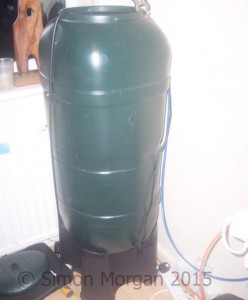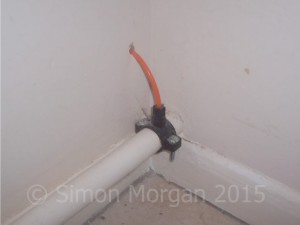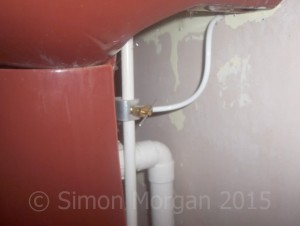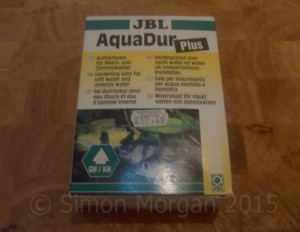Reverse osmosis, or RO water as it’s often referred to, is often used in fishkeeping to help fishkeepers tailor the water conditions in their tanks to the exact requirements of their fish. It can sound complicated, but is actually not that hard to grasp. The article below will take you through the basics and give some suggestions on setting up a reverse osmosis unit for yourself.
I have often heard the phrase “I can’t afford RO” or “I don’t want the hassle”, but I believe reverse osmosis water is cheap and easy to produce, and is equally valuable to keepers of large Central American or Rift Lake cichlids as it is to discus keepers and dwarf cichlid enthusiasts.
How many times have you lost fish after a water change and couldn’t explain it? How much is your livestock worth? I believe RO water is an insurance policy for your livestock and it can be adapted easily for fish from any body of water, whether that means the blackwaters of the Amazon or the hard alkaline water of a lake such as Tanganyika.
“Water is life’s mater and matrix, mother and medium. There is no life without water.” Albert Szent-Gyorgyi Hungarian Biochemist, 1937 Nobel Prize for Medicine, 1893-1986.
The different aspects of water
To understand what you’re getting as a result of using a reverse osmosis unit, and why you might want to make adjustments to your tap water, it’s useful to understand what the different components of water are. Water isn’t just water, the same the world over. Fish are adapted to live in certain types of water such as hard water (where your kettle furs up) or soft water or somewhere in between. Different types of water have different levels of certain things:
pH stands for Potential of Hydrogen and is the measure of how acidic or alkaline a solution is. At a molecular level this means the concentration of hydrogen ions (H+).
GH stands for General Hardness and measures calcium and magnesium as well as certain other minerals. GH alone does not influence pH. You only need to worry about false GH readings if adding Iron fertiliser.
KH measures carbonates and is independent from GH, but but but, most tap water contains lime which is calcium carbonate so you tend to get GH and KH in parallel. It’s possible to have high GH and low KH e.g. a solution of Epsom salts aka magnesium sulphate, or the opposite e.g. a solution of sodium bicarbonate. KH directly influences pH.
TDS literally means Total Dissolved Solids so it measures everything in solution. That includes fish waste, fertilsers, dechlorinator, tannins, common salt etc. A solution of common salt has high TDS but zero GH and KH for example. TDS is important to fish, however in nature low TDS tends to mean low pH (& GH + KH) and vice versa and generally speaking if you get the TDS correct for your fish the pH will be in the correct range.
To complicate matters KH is involved with the chemical reactions that occur during the nitrogen cycle. As ammonia is metabolised by bacteria so are carbonates. This leads to a drop in KH and pH over time. If the KH is low to start with, or not replenished, the filter bacteria stop working. At the same time, the pH crashes and ammonia builds up. Some people call this “Old Tank Syndrome”.
At low pH ammonia becomes ammonium which is less toxic. However, if the aquarist decides to do a large water change, the pH may rise back above 7 and the ammonia becomes toxic again. The fish become very sick, very quickly and may even die. Many species will be badly affected by the drop in pH, and this alone can prove fatal for some.
What does reverse osmosis mean?
To understand reverse osmosis, you need to understand osmosis.
“Osmosis is the movement of solvent molecules through a selectively permeable membrane into a region of higher solute concentration, aiming to equalise the solute concentrations on the two sides.”
Pardon? Try to imagine an aquarium divided down the middle by a semi-permeable membrane through which only water can pass. Now imagine pouring salt into one half of the aquarium. The water molecules move from the unsalted side to the salted side in order to equilibrate the salt concentration, the level of water rises on the salty side and drops on the other. Weird huh? This phenomenon can be demonstrated using eggs:
Osmosis demonstration
Now try to imagine applying pressure to the salted side of the aquarium. The pressure overcomes the osmotic force and fresh water moves from the salted side to the unsalted side – hey presto – reverse osmosis. This is essentially what happens inside an RO unit.
Reverse osmosis water is essentially water with everything contained within it removed. There should be no nitrate, no chlorine, no minerals etc. Think of it as a blank canvas that you can then add things to in order to make the sort of water conditions that your fish prefer. You end up with your ’empty’ water, your blank canvas, and waste water which contains all the things that have been removed from your RO water.
How does a reverse osmosis unit work?
A large surface area is needed for a reverse osmosis membrane to produce useful amounts of water, so the membranes are wound into a spiral and packed into a cartridge. Water moves “tangentially” across the surface of the membrane, purified water passes through and becomes the “product”, concentrated water, the “reject”, goes to waste. A good membrane can reject 99% of the contaminating ions, organic compounds and particulates from the feed water.
Unfortunately, RO membranes are quite sensitive to chlorine, bacterial fouling and particulates. However, most manufacturers provide some form of protection from these tap water contaminants.
The image below clearly shows the carbon filter, left, (protects the membrane from Chlorine which can punch holes through it) and the 5 micron filter, right, that removes particulates which again, damage the membrane by scratching.

Bacterial build up and scaling can also affect the performance of the RO membrane and this can be reduced by regular flushing (see manufacturer’s instructions). In areas of particularly high hardness, a softener could be installed. Regular maintenance of your system can keep the membrane healthy and significantly extend its useful life.
I’m worried about the waste water from a reverse osmosis unit
This is especially important if you are on a water meter, obviously, but reverse osmosis reject water is still pretty good and can be used for the garden, washing the car etc. etc. or if you live in an ultra-modern home, can be added to the “grey water” system.
The efficiency of the membrane is also dependant on the pressure and temperature of the feed water so if possible place the RO system in a warm place and avoid running on particularly cold evenings. It’s also possible to acquire diaphragm pumps from the manufacturer which will increase the product/reject ratio and reduce waste.

My tap water is perfect for my fish. Why do I need a reverse osmosis unit?
Tap water is becoming less and less predictable and more and more polluted. You may be lucky and live in a soft water area and keep Apistogrammas, but I know of at least one occasion where a wellknown breeder has lost several tanks of rare Apistogrammas after a water change for no known reason. A commercial breeder in Essex who relied on rain water was in the news due to the “drought” in 2011. In my humble opinion, he should have RO as a backup!
I, personally, have perfect water most of the year for hard water cichlids. Unfortunately, being in an arable area, there are occasional peaks in nitrates and presumably in other fertilizers and pesticides. I prefer RO water as it contains no detectable nitrates. I mainly keep soft water dwarf cichlids as a result, but I use minerals and additives to produce hard, alkaline water for a tank of Tanganyikans.
I know many East Anglian fishkeepers who struggle with high nitrate contamination in tap water and as we see above, we can’t rely on the rain supply either!
OK, I’m convinced, what do I need to set up my own reverse osmosis unit?
I’ve built up my equipment gradually but now I have a good system in place for producing and storing RO water. First, get a good system. Mine is shown above, it’s a 50gpd (gallons per day) system from D-D Aquarium and comes as a complete kit including carbon and 5 micron prefilter cartridges, pierce valve and saddle valve. Other systems are available but get one that matches your daily needs (as it’s better to run constantly than to be stagnant) and includes carbon and prefilters. Units with just an RO membrane will be short lived and are a false economy.
Invest in a water butt from the garden centre and if you can stretch to it, a sump-pump and ball valve. This will save you all the back-breaking work of hefting buckets of water around. The ball valve prevents unfortunate accidents! It’s also worth picking up a TDS meter, more on that below.

Shopping list for a reverse osmosis unit and set up:
- Quality RO System
- Water butt
- Ball valve
- Sump Pump and hose
- TDS meter
- Additives
Do I need a plumber to install my reverse osmosis unit for me?
No, installation is easy. Just remember to attach the saddle valve first then the pierce valve… My fishroom is adjacent to a bathroom so the piping is fed through the adjoining wall;


Follow the manufacturer’s instructions to the letter and give the membrane a good flush before collecting the product.
Great, so now my water is lovely, can I keep fish in it?
No! Straight reverse osmosis water is too pure for most fish. Pure RO has practically no KH, GH or TDS. It has a theoretical pH of 7 but any small impurity will swing the result, even CO2 from the air. Clearly this is inappropriate for most fish, so how should you prepare it?
Firstly, it takes some time to make so you might as well add an air stone to the storage container as RO even removes oxygen. You may even choose to add a heater but that is optional.
Finally, you need to add buffers or minerals to match the requirements of your chosen fish. To do this you must research the fish you have and find the optimum conditions for keeping them.
Researching fishkeeping – how, what and why?
Luckily you can purchase commercial reverse osmosis minerals (or make your own) that do a very good job and simply adjust the TDS to what you need. The GH, KH and pH will fall roughly in range.
However if you need to raise GH or KH a little more this can be done by adding calcium sulphate or chloride for GH, or sodium or potassium (bi)carbonate for KH. Some plant keepers prefer the latter as potassium is an important element for plants.
Adjusting pH is not usually necessary but raising KH will raise pH so that’s easy but reducing pH requires some care. If TDS/GH/KH are high then adding acids is pointless as you only achieve hard, acidic water which is completely unnatural. But if you have soft water and want to drop the pH a little then commercial “pH down” products can be used but organic acids from alder cones, leaves or bogwood are less hazardous to handle and won’t cause sudden pH drops. Always monitor pH and KH closely if using anything to lower pH, not forgetting that low pH/KH can cause filtration to fail.
As I said above, I mostly keep soft water dwarf cichlids. To prepare water for these fish I add a commercially available remineralisation mix to the water butt until the reading on the TDS meter reaches 100ppm. Usually that means 3 teaspoons.

To reduce the pH, I use alder cones and beech leaves. If I need really low pH and TDS for a breeding project I just use half the amount of remineralisation mix and allow the pH to drop naturally. I have been able to spawn Apistogramma iniridae using this method.
For my Tanganyikan cichlids I raise the TDS to 350-400ppm and add a little sodium bicarbonate to bring the pH above 8, although I’m sure coral sand or similar would achieve the same result. This could easily be adapted for other cichlids such as mbuna or Central Americans.
Summary
Reverse osmosis not only removes hardness but also nitrates, phosphates and many other nasties like pesticides, resulting in healthier fish and more spawnings with the added bonus of less algal growth. It may seem a bit of a hassle to the uninitiated, or pointless if keeping hard water cichlids or other hard water species, but unreliable tap water and generally high nitrates across the UK make it an attractive option. It really is cheaper than losing a tankful of valuable fish and opens up the possibility of keeping cichlids from anywhere in the world!
Author and photos: Simon Morgan




